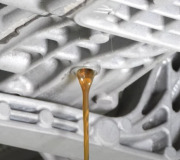There are many oils out there that call themselves synthetic, but not all are created equal, and that is important to know. You do get what you pay for. Group III synthetic oils only use about twelve percent synthetic base stocks. The rest is hyrdocracked petroleum base stocks. For major oil companies who have their money in crude oil refining, the word "synthetic" is merely a marketing term. It does not mean one hundred percent, but just that a percentage of synthetic base stock goes into their product.
The oils that are commonly mentioned are Group II and Group III synthetics with the exception of Royal Purple, which is a Group V. AMSOIL is a Group IV synthetic (PAO) but also uses Group V Ester technology. It gives you the best of Group IV and Group V synthetics. Mobil 1 is a Group III synthetic. AMSOIL is a Group IV synthetic.
In the late 1990's, Castrol started selling an oil made from Group III base oil and called it SynTec Full Synthetic. Mobil sued Castrol, asserting that this oil was not synthetic, but simply a highly refined petroleum oil, and therefore it was false advertising to call it synthetic. In 1999, Mobil lost their lawsuit. It was decided that the word "synthetic" was a marketing term and referred to properties, not to production methods or ingredients. Castrol continues to make SynTec out of Group III base oils, that is highly purified mineral oil with most all of the cockroach bits removed.
Shortly after Mobil lost their lawsuit, most oil companies started reformulating their synthetic oils to use Group III base stocks instead of PAOs or Diester stocks as their primary component. Most of the "synthetic oil" you can buy today is actually mostly made of this highly-distilled and purified dino-juice called Group III oil. Group III base oils cost about half as much as the synthetics. By using a blend of mostly Group III oils and a smaller amount of "true" synthetics, the oil companies can produce a product that has some of the same properties as the "true" synthetics, and nearly the same cost as the Group III oil. AMSOIL differs from Group III oils. As a Group IV oil, it uses 100% pure synthetic base stocks. This is why you can run it for longer intervals.
Synthetic oils were originally designed for the purpose of having a very pure base oil with excellent properties. By starting from scratch and building up your oil molecules from little pieces, you can pretty much guarantee that every molecule in the oil is just like every other molecule, and therefore the properties are exactly what you designed in, not compromised by impurities. Synthetics were thus originally a reaction to the relatively poor refining processes available from about 1930 to about 1990. The original synthetics were designed for the Army Air Force in WW II. They simply could not make their high- performance turbo-charged radial engines stay alive on the available motor oils of the time.
One process for making synthetic base oils is to start with a chemical called an Olefin, and make new molecules by attaching them to each other in long chains, hence "poly." The primary advantage of Poly-Alpha-Olefin "PAO" base oil is that all the molecules in the base oil are pretty much identical, so it's easy to get the base oil to behave exactly as you like. PAOs are called Group IV base oils.
These PAO base oils have an enormous advantage over mineral base oils in low temperature performance and in resistance to oxidation, which is critical in keeping the oil from forming acids.
Another type of base oil is made from refined and processed esters and is called Group V. Esters start life as fatty acids in plants and animals, which are then chemically combined into esters, diesters, and polyesters. Group V base stocks are the most expensive of all to produce. However, the esters are polar molecules and have very significant solvent properties an ester base oil all by itself will do a very decent job of keeping your engine clean. So, people who are serious about making a superior oil will usually mix some Group V oils into their base stock.
Oils that are strictly Group V ester oils tend to be better suited for high RPM, hot running, air cooled engines. One hundred percent ester based oils are usually more expensive than Group IV oils, and don't have the longevity of PAO (Group IV) or PAO/Ester mixes oils. Group V oils perform very well in the shorter term. They perform very well in race engines and in applications where drain intervals are factory spec or shorter, whereas Group IV oils are better suited for the long haul of extended intervals.
Whatever oil you choose, know what you are buying. Just because the jug says "synthetic" doesn't mean it is made from One hundred percent pure synthetic base stocks.
Synthetic oils do not cause leaks. What they do is clean everything inside your engine. If you had a faulty seal or gasket that was being clogged by conventional oil sludge, the synthetic (especially Group IV and V oils) will clean out the sludge deposits and cause the leak to finally start. That said, it is a very rare occurrence. I switched over a 1993 Dodge Ram 1-ton Cummins over a year ago. It had never seen synthetic before. Now it is sixteen months later and not a drip. If your gaskets and seals are in good condition, switching over will not cause a leak. What you will gain is extended drain intervals and better protection, as well as better cold weather performance.
SPONSORED LINKS
Friday, February 17th, 2012 AT 4:13 AM


